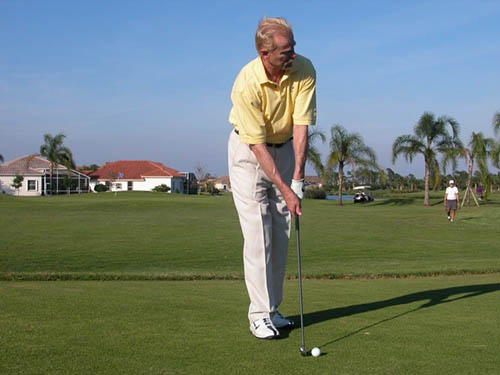Golf Fundamentals: Always Sweat the Small Stuff

by Dr. T.J. Tomasi A Legacy Post by Keiser University College of Golf Senior Faculty and Director of Research (1940-2023)
Napoleon lost at Waterloo because someone in his army forgot to bring the nails to disable the cannon so they couldn’t be used by the enemy if the gun emplacements were overrun. And as fate would have it, at one point in the battle, the French line was breached, and the enemy turned the captured French guns against them with devastating results. At Antietam, a Union foot soldier found the secret orders for General Robert E. Lee’s entire battle plan left in a field tent wrapped around some of Lee’s fine cigars. This oversight handed the North a decisive battle in the Civil War. And because of an error in punctuation in a handwritten field order during the Battle of Balaclava, into the valley (the Valley of Death) lined with enemy cannon and sharpshooters, rode the 600 to their slaughter.
These failures to attend to small details were tipping points of history, and they teach a valuable lesson for all golfers: Sweat the small stuff. Most golfers think that when a tour player takes a lesson, it’s on special elements of the swing that are too complicated for the average bear, but that’s not true. It’s mostly mundane things, the same things you should take care to include in your swing. For example, one of golf’s greats, Jack Nicklaus, took a brush up series of lessons at the beginning of each tour season from his teaching pro-Jack Grout featuring grip, stance, aim, etc., aka the fundamentals. In the next two articles, I’m going to run through the swing process so you can incorporate the important “little things” in your swing that are easy to overlook, such as the pre-shot routine, or as I like to call it, “the ritual.”
Golf Fundamentals
Golf, throughout its history, combines skill, precision, and patience. The foundation of golf itself involves mastering the game’s core fundamentals. From the way you grip the club to the way you position your body, every element plays an integral role in achieving consistency and success on the course. These fundamentals act as stepping stones for every golfer, guiding players to improve their accuracy, control, and approach to each shot. Without a solid understanding of these basics, even the most talented golfer will struggle to unlock their full potential. As a golfer, the goal should be to continue to improve your grip, stance, swing, and follow-through. Doing this will not only improve your game, but you’ll unlock a deeper connection and appreciation of golf itself.
Golf Fundamentals: The Ritual
Of course, golf requires physical power, but it also requires another kind of power: the power of the ritual, a golfing amulet that has the ability to turn a playing field into a safe haven. Once personalized, the sequence and composition of the parts of the ritual never vary, and it is this sameness that gives the brain solace, no matter how stressful the situation. The power of your golf ritual comes from the exact repetition of a sequence, a repetition that creates an aura of control, even when things are going poorly. If you are surprised at the importance of adding a ritual to your golf game, then you are in dire need of one, so be sure to see the next installment on this topic.


Golf Fundamental 2: Setup Position
In the complex world of golf, the setup position is not just a starting point—it’s the foundation on which every swing is built. The alignment of your feet, shoulders, and clubface is critical to creating a shot that stays on target. But beyond mere alignment, the setup position also dictates your balance, posture, and ability to generate power. A proper setup ensures consistency from the very first tee to the final putt, providing the golfer with a stable base from which to deliver smooth, controlled swings. The importance of this fundamental cannot be overstated; a poor setup can lead to misaligned shots, inconsistent ball striking, and lost confidence. Mastering your golf setup can enhance accuracy, power, and precision.
Golf Fundamental 3: Stance and Posture
When it comes to building a repeatable and effective golf swing, your stance and posture form the backbone of the entire movement. How you position your feet dictates your balance, while your spine angle influences your swing plane, and together, they create the foundation for a powerful and controlled strike. A balanced stance, where weight is distributed evenly, allows for rotation and enhances your ability to generate power. Additionally, maintaining a solid posture helps stabilize your swing and keep your body aligned during each phase of your swing. Golfers who master this fundamental not only experience better control over their shots but also find they can maintain their energy and precision throughout a long round. Fine-tuning your stance and posture can be the key that unlocks a more consistent, reliable swing.
Golf Fundamental 4: The Grip
A golfer’s grip on the club is often described as their connection to the game itself, a blend of strength, precision, and flexibility. How you hold the club sets the tone for your entire swing, influencing everything from the initial takeaway to the point of impact. A proper grip aids in a smooth and powerful swing arc, allowing the clubface to strike the ball square. A grip that is too tight can lead to tension in your hands and forearms, hindering your ability to swing freely. Conversely, a grip that is too loose can result in erratic and inconsistent ball striking. Practicing the balance of grip pressure, hand placement, and wrists can improve shot accuracy and distance significantly. By mastering the connection between your hands and the club, you’ll feel confident during your swing and feel in control of your game.
Golf Fundamental 5: Backswing
In the fluid sequence of a golf swing, the backswing acts as the coiled spring, storing potential energy that will be unleashed upon impact. A well-executed backswing is more than just lifting the club—it involves the coordinated rotation of your shoulders, hips, and arms, setting the stage for the powerful downswing to follow. The position of the club at the top of the backswing will largely dictate the quality of your shot, determining both the direction and distance of the ball. A strong backswing ensures that your clubhead travels along the correct path, allowing you to deliver a precise, controlled strike. However, this movement requires balance, timing, and flexibility; too quick or too steep, and the entire swing can fall apart.
Golf Fundamental 6: Proper Release
The release is the pinnacle moment of any golf swing—the instant when everything comes together, and the stored energy within your body and club is transferred to the ball. A proper release is all about timing, where your hands, arms, and body work in harmony to square the clubface at the moment of impact. This crucial movement allows you to maximize distance and control, delivering a shot with both power and precision. The art of the release requires confidence and coordination; too early, and you may push the ball wide; too late, and you might pull it left. Practicing your release also helps avoid hooks and slices, allowing for straighter and more consistent ball paths. Understanding how to release your club can elevate your game, allowing you to drive the ball with greater finesse.
Learn more!
Want more tips? If you want to take your game to the next level, contact our team at Keiser University’s College of Golf & Sport Management today. With our dedication and experience, we can elevate your game to new heights together. Give us a call today at 888-355-4465.














